Are you planning a visit to the Capitoline Museums in Rome and have a passion for Greco-Roman sculpture? This museum is a top destination for anyone looking to delve into the ancient world, and I’ve got the perfect guide for your visit.
Situated on the prime real estate of the Piazza dei Campidoglio on Capitoline Hill, the Capitoline Museums are not only Rome’s oldest public museum but also among the city’s best. They offer a unique window into life before the fall of Rome.
The collection is housed in two buildings, the Palazzo dei Conservatori and the Palazzo Nuovo. You’ll enter through the Conservatori, which is to your right as you ascend the ramp.
The museums boast an unparalleled (though somewhat disorganized) collection of ancient art and artifacts. You’ll find some of the world’s most famous sculptures like the She-Wolf, Dying Gaul, and the Equestrian Statue of Marcus Aurelius.
Connecting the two buildings is the evocative Underground Galleria Lapidaria, an underground passageway formerly used as Rome’s state archives.
The corridor is lined with poignant funereal steles. But the best part is that you’ll have a spectacular view of the Roman Forum.
Tickets & Tours
In high season, you’ll want to pre-book a skip the line ticket. You also have free entry with the Rome Pass.
Because the museum is so vast, you may also want to book a guided tour. Or, if you’re a real ancient history buff, book a private tour.
History of the Capitoline Museums
The Capitoline Museums were launched in 1471 with a bequest of bronze statues from Pope Sixtus IV. More donations flowed in.
In the 16th century, Pope Pius V made another donation. He essentially purged the Vatican of the “undesirable” pagan and mythological art. Excavations in Rome unearthed other artifacts that landed in the museum.
The Capitoline Museums were initially private. In 1734, Pope Clemente XII opened the museum to the public.
It’s considered the world’s first public museum. It boasts an enormous array of ancient Roman, medieval, and Renaissance art — statuary, paintings, and relics.
The objets d’art are staged within gorgeous marbled rooms filled with tapestries and frescoes.
The museum is more suited to aimless wandering than a targeted assault. If you’re an art lover, I’d allot 3 hours for perusal or you’ll might miss key pieces.
Guide To The Capitoline Museums: What To See
The museum is filled with treasures. There are some seminal, historically significant pieces.
Here are the 15 highlights you can’t miss.
1. Colossus of Constantine, 312–315 AD
You begin in the museum courtyard. It contains the ruins of one of the most spectacular sculptures from the ancient world. You’ll find large marble chunks of what was once a massive painted statue of Constantine the Great on his throne.
Intact, the colossus was once 40 foot tall. It was discovered in the Roman Forum in the 15th century in the Basilica of Maxentius.
Constantine was the first Christian emperor of Rome. In the colossus, his face is fierce and almost frightening, a departure from the previous bust-style of emperors.
The colossus was carved from white marble with a brick core. Look closely and you’ll see a bulging vein in the forearm.
When you’re done admiring the rest of the courtyard, take the Ripiano Staircase up to the main galleries. The vaulted ceilings were decorated by Lucy Luzi in the 16th century.
2. Bust of Commodus as Hercules, late 2nd century
Most of us know bad boy Commodus from the movie Gladiator. As portrayed, he was the bratty son of the philosopher-emperor Marcus Aurelius.
Commodus fancied himself a gladiator. He used to drape himself in animal skins for dramatic effect. Here, you can a lion wrapped around him in a megalomaniacal way.
This bust of him is considered a remarkable and well preserved piece of ancient Roman sculpture, dating from the late 2nd century. Although Commodus’ memory was damned (like Nero’s), somehow this piece survived intact.
The sculpture has all the signs of Hercules — the club, the lion’s skin, and the golden apples of Hesperides. Commodus liked to engage in staged gladiator fights in the Colosseum. Often, he’d beat people to death with his club.
The rough jock image of Commodus is paired with self indulgence. Notice the manicured nails and perfectly coiffed hair.
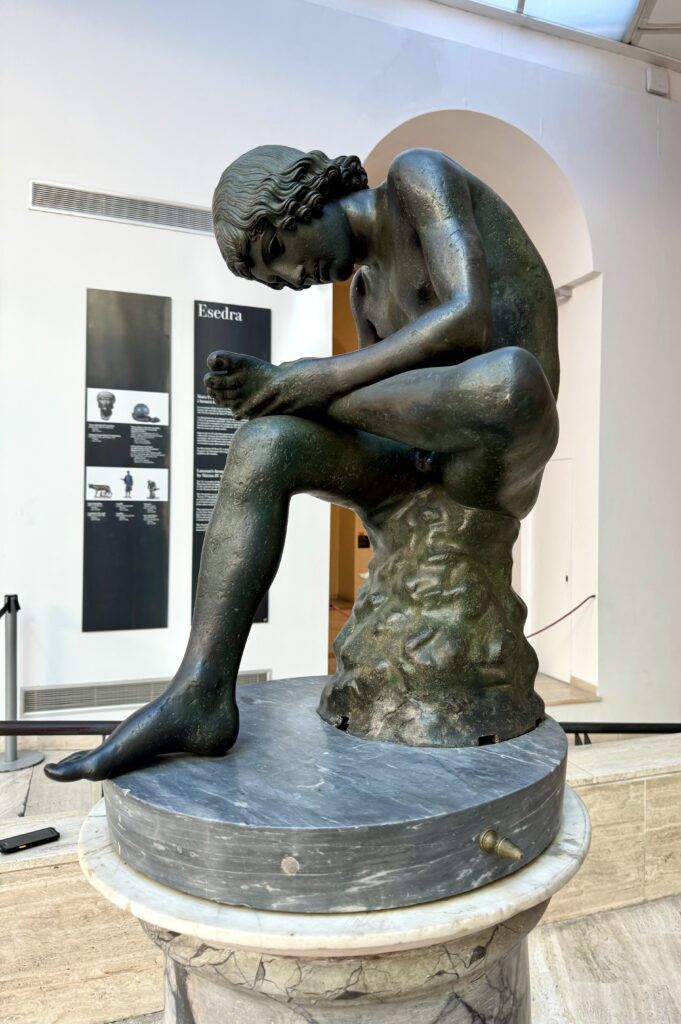
3. Spinario, Boy Extracting a Thorn, 1st century BC
Spinario is an ancient bronze statue in the Hellenistic style, which departed from idealized portrayals and favored depictions of daily life. It was likely made by Greek sculptors in Rome.
This sculpture captures a genre scene. You see an innocent boy in a mundane moment of his life.
With intense concentration, he’s trying to extract a thorn from his foot. The detail is extraordinary.
The statue is also known as The Faithful Boy. Legend holds that a loyal shepherd boy was delivering an important message for the Roman Senate. En route, he paused only once to pull a painful thorn from his foot.
The Spinario became a popular theme for artists. It was one of the first Roman sculptures to be copied by early Renaissance artists.
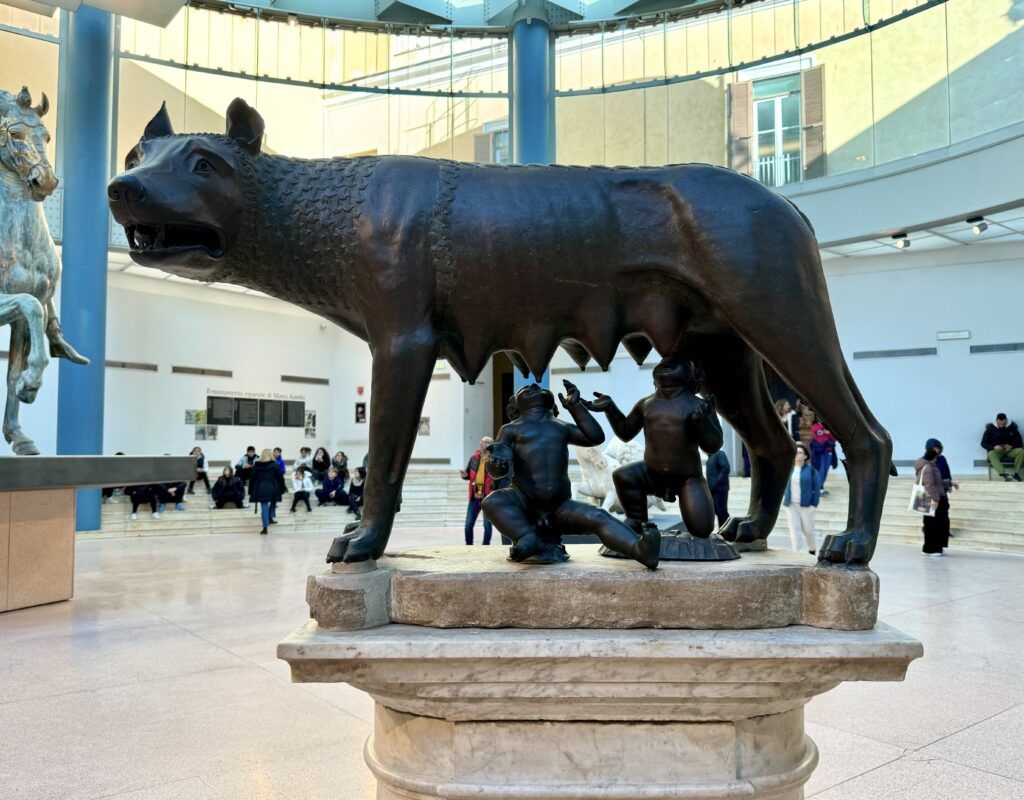
4. Capitoline She-Wolf, 5th Century BC
The Capitoline She Wolf is a celebrated bronze masterpiece dating from the 5th century BC. Now, that’s ancient.
Pope Sixtus IV donated it to the museum. The She-Wolf then became the symbol of Rome and the representation of its foundation myth.
Legend holds that Rome was founded by the the twins Romulus and Remus. The boys were abandoned by their mother. They were suckled by a she-wolf and then rescued by either shepherd or river god.
The twins made their way to a future Rome. Once there, a sibling spat ensued. The brothers wanted to found the city on different hills.
Romulus liked Palatine Hill, while Remus preferred Aventine Hill. Romulus killed off his brother to settle the dispute and named his city “Roma” after himself.
The figures of Romulus and Remus as infants were added to the sculpture to enhance the legend. Originally on the facade of the Palazzo dei Conservatori, the sculpture was moved inside for protection. A copy is outside now.
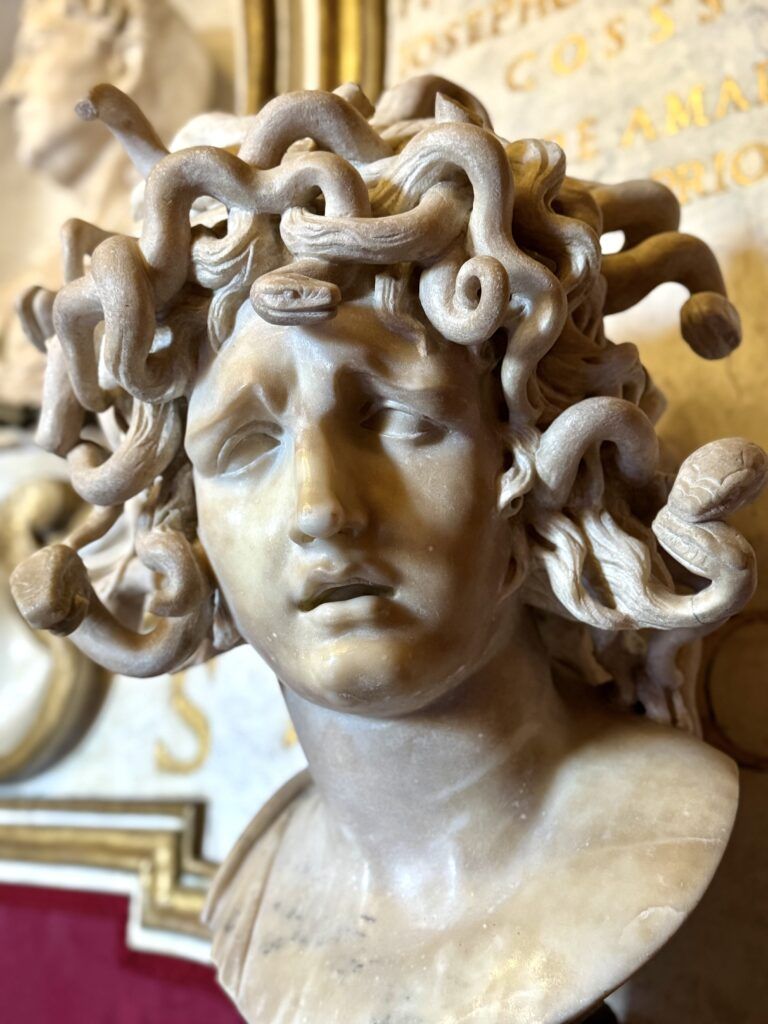
5. Gian Lorenzo Bernini, Medusa, circa 1630s
Set under a Murano glass chandelier in the Hall of Geese, this bust is truly amazing.
It was created by the master of marble and virtual inventor of Baroque sculpture, Gian Lorenzo Bernini. In it, Bernini captures the anguish of Medusa, the snake-haired woman with a petrifying glare from Greek mythology.
According to the poet Ovid, Medusa was renowned for her loveliness. But when Poseidon raped her in the Temple of Athena, Athena was ticked off. She transformed Medusa’s glorious mane of hair into snakes — a symbol of female rage.
This way, Medusa’s enemies were numbed with fear and turned to stone. Medusa became both a beautiful victim and a monstrous villain, put to use by Perseus.
In Bernini’s rendition of the myth, Medusa is shown alive and in the very moment of transformation. Medusa peers into an unseen mirror in anguish. (Bernini likes transformative moments. You see this in his Apollo and Daphne sculpture in the Borghese Gallery.)
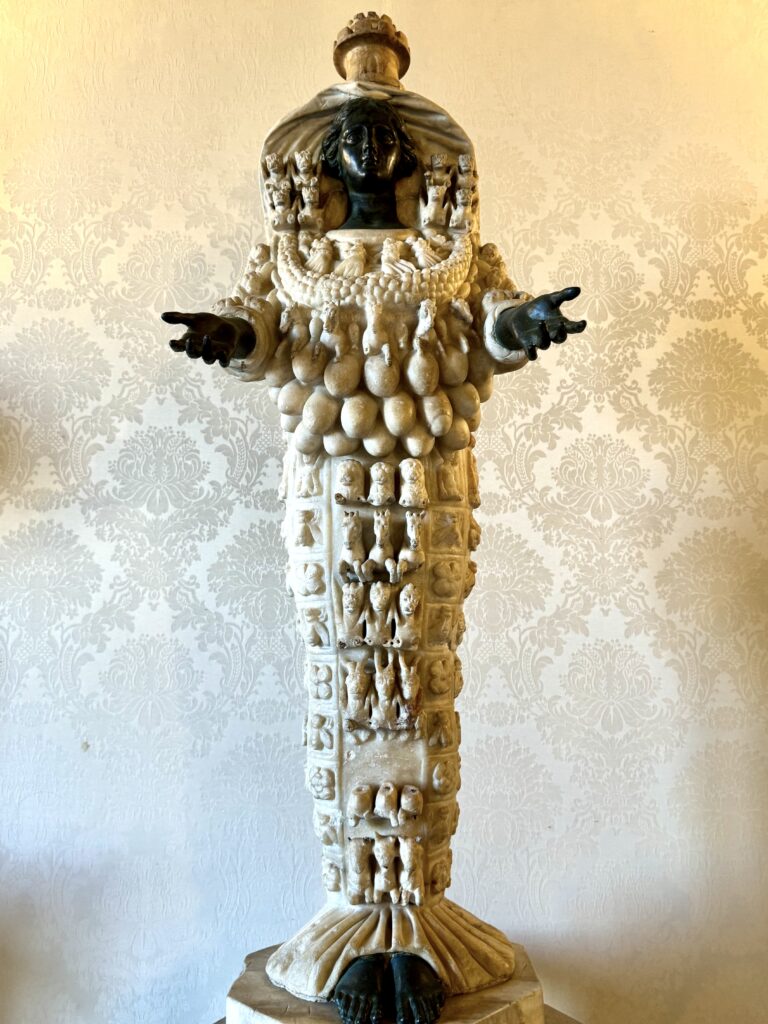
6. Artemis of Ephesus, Roman copy of 2nd Century BC
There are many statues in Rome of Artemis of Ephesus, testifying to the popularity of her cult.
I saw statues in the Capitoline Museums, the Vatican Museums, and at Ville D’Este in Tivoli. According to mythology, Artemis was the daughter of Zeus and Leto and the sister of Apollo.
In this cult statue in the Hall of Eagles, she’s shown in sarcophagus-like stance with a tapered body signifying power.
She’s adorned with oval shapes that look like breasts. But they’re not; they’re bulls testicles. They’re also some flowers and bees thrown in for good measure.
The decorations signaled her role as the Greek goddess of fertility. Her hands are outstretched. They show her desire to promote fertility.
7. Equestrian Statue of Marcus Aurelius, 176 AD
This statue is antiquity’s greatest surviving equestrian statue and may be the museum showstopper. Equestrian statues were popular in imperial Rome.
They celebrated an emperor’s civic and military accomplishments, and were often copied on coins. The horse is particularly compelling, caught in a moment of movement.
This sculpture originally may either have graced the Roman Forum or decorated the Church of St. John Lateran. Later, it was moved to the center of the Piazza del Campidoglio.
Now, there’s now a 16th century copy in the square. The original is protected from the elements in a modern glass hall.
Marcus Aurelius was known more for his philosophical treatise, Meditations, than battlefield exploits. In the statue, he is making his famous gesture of clemency, pardoning the defeated Germanic tribes.
You will be blown away by its scale and realism. It’s a truly majestic work of art in bronze.
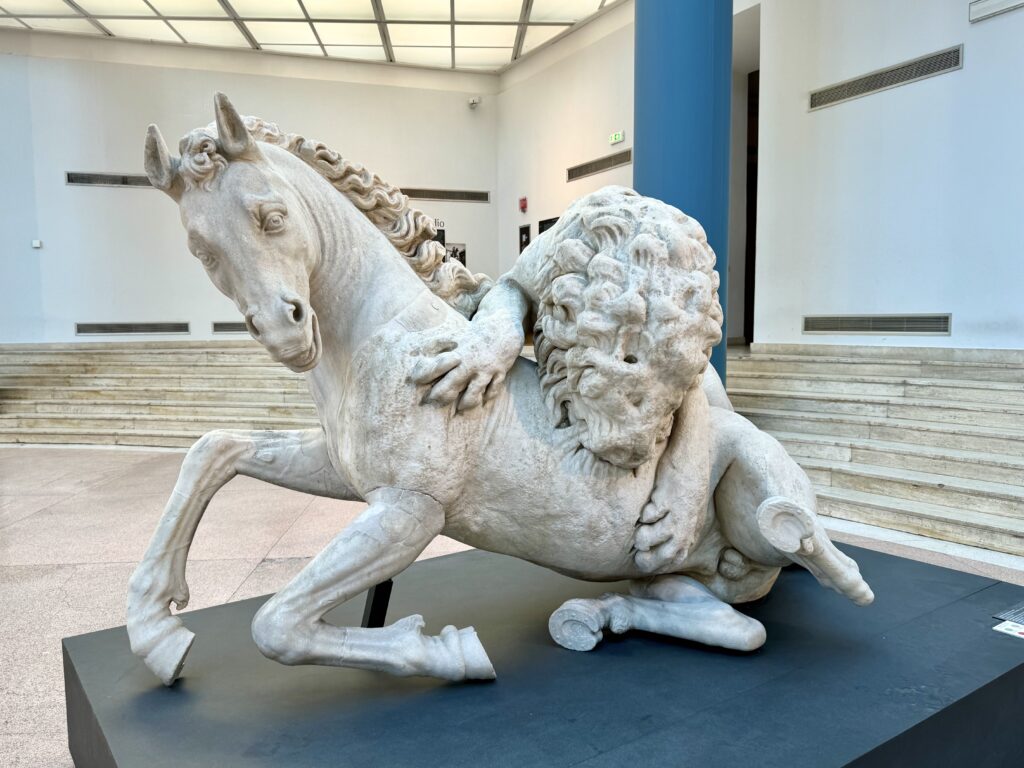
8. Lion Attacking a Horse, 325-300 BC
In the same hall as Marcus Aurelius, you’ll find the sculpture Lion Attacking a Horse. It’s one of the most famous sculptures to survive from antiquity. Michelangelo described it as “most marvelous.”
The sculpture was most likely created after Alexander the Great’s conquest of Persia. During this time, lion-slaying scenes in mosaics and sarcophagus reliefs proliferated. It may have been displayed in the Circus Maximus before arriving at the Capitoline Museum.
The Lion Attacking a Horse is an emblem of triumph and defeat. The ferocious lion was the symbol of Rome (before the She Wolf), representing both ruthless political and battlefield dominance.
The sculpture dates from the early Hellenistic period when Greek sculptors began using realistic portrayals of intense emotion and physical exertion.
9. Tabularium
If you take the subterranean tunnel, you’ll see some excellent funeral steles, inscriptions, original marbles, and stones from the Roman Forum. My favorite piece was the gravestone of a chariot racer.
Then, you’ll arrive at the Tabularium. These 1st century rooms once held the archives of Rome.
They offer a stunning view over the Roman Forum. Talk about getting bang for your buck with your museum ticket!
10. The Dying Gaul, 1st or 2nd century AD
This marble sculpture is probably the most famous sculpture in the museum. It’s a 1st century Roman copy of a Greek original. It celebrates the Greek’s defeat of the Galatians.
Dying Gaul portrays a Gallic warrior in his final moments, his face contorted in pain as he falls from a visible fatal chest wound. It’s a very emotive piece.
The sculpture shows both courage in defeat and composure in the face of death. It’s famed for its anatomical accuracy and realism.
Dying Gaul was found in the gardens of the Villa Ludovisi in the 17th century. The sculpture is a Roman copy of a Greek bronze original from the 3rd century BC.
It was initially identified as a gladiator. But telltale symbols on the base of the sculpture prompted historians to correct that designation.
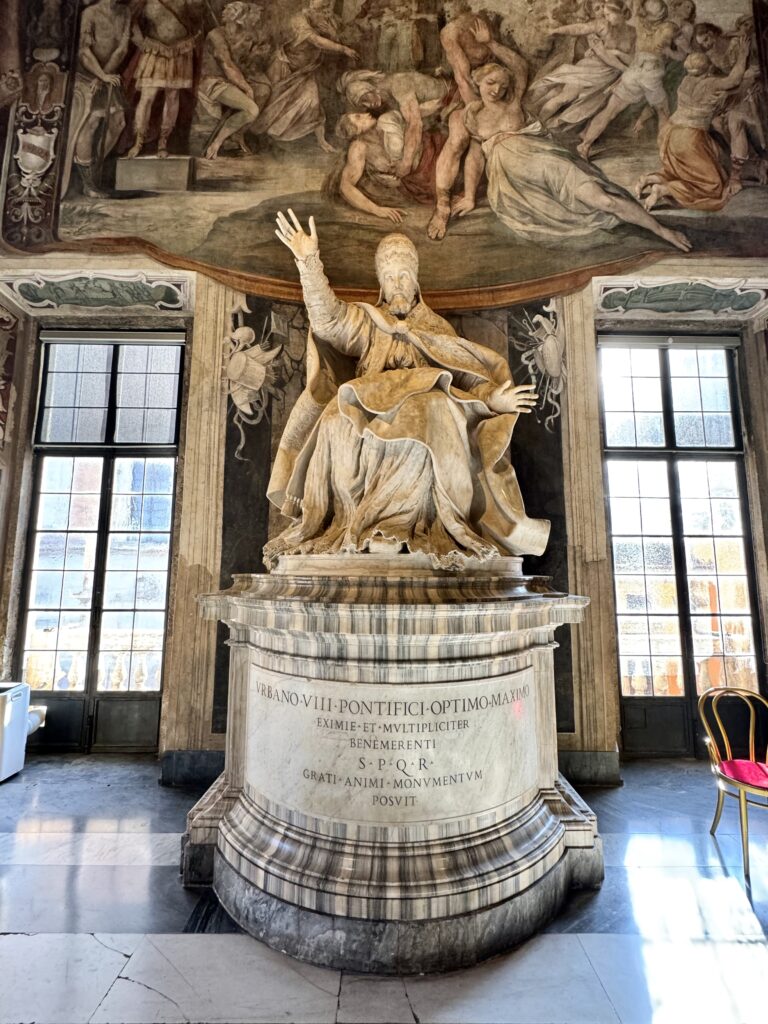
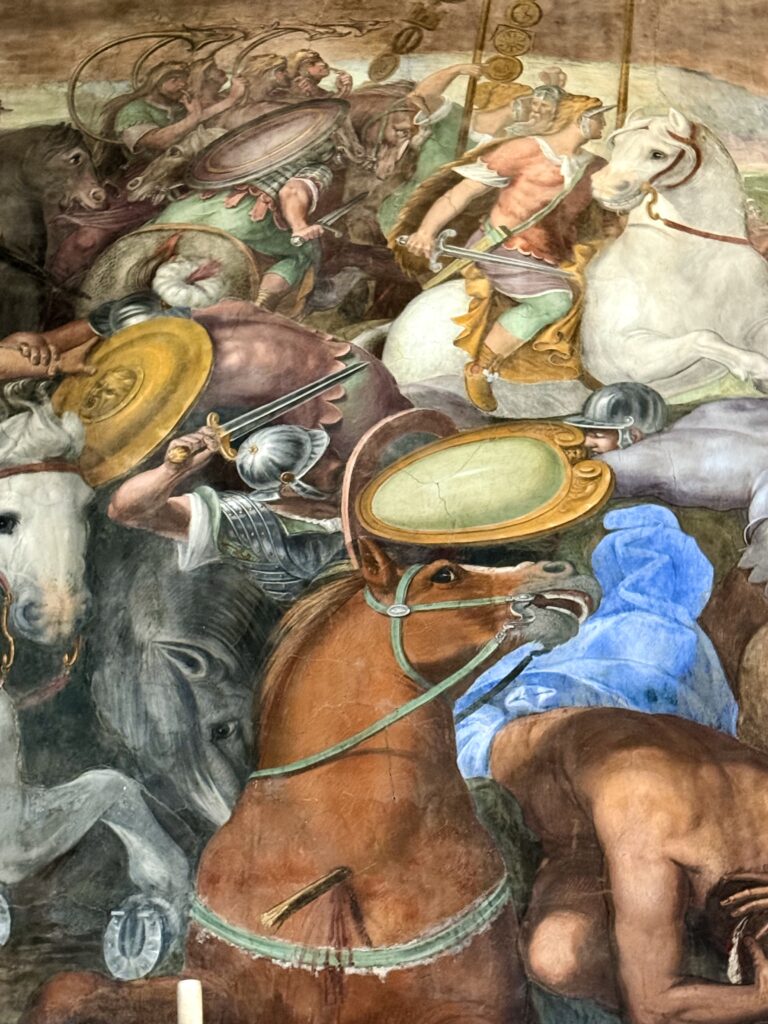
11. Hall of Captains
If you’ve been on a day trip to Hadrian’s Villa Adriana, you’ll want to inspect the Great Hall closely. It’s simply crammed with sculptures looted from or found at the villa.
Perhaps the most famous sculpture is the Wounded Amazon, based on a Greek original by Phidias. The amazons were said to have founded the Temple of Artemis at Ephesus.
The Capitoline’s piece has been extensively restored. While of ancient origin, the head likely doesn’t belong to the statue. It’s also possible she was originally holding a spear, not a bow.
The Great Hall is also a gorgeous room and the museum’s largest space. It has a 16th century gilded wood ceiling and frescos that look like “tapestries” By Sebastian del Piombo.
Two key statues in the room are Alessandro Algardi’s bronze statue of Pope Innocent X, of Doria Pamphilj fame, and Bernini’s marble statue of Pope Urban VIII.
12. Caravaggio, St. John the Baptist, 1602-03
Compared to the spectacular collection of sculpture, the Capitoline Picture Gallery on the top floor is rather middling. But it does have two paintings by Caravaggio, the famed italian Baroque painter.
Saint John the Baptist was one of Caravaggio’s favorite subjects. This painting may be his most controversial depiction.
It didn’t conform to conventional counter-Reformation works. It was too naturalistic, a provocative nude. People suspected that Caravaggio was guilty of sodomy.
The actual subject of the painting has been debated over for years. Some think it’s the biblical Isaac and the ram, just a shepherd boy, or a random model. However, the man who paid for the work asked for a John the Baptist, hence the title.
13. Caravaggio, The Fortune Teller, 1594
Caravaggio painted two versions of The Fortune Teller. One is in the Capitoline Museums and the second version is in the Louvre.
The Fortune Teller shows a pretentiously dressed boy, having his palm read by a gypsy girl. The unsophisticated boy looks with anticipation as the girl returns his gaze with a fake smile.
There’s a sleight of hand. The girl is slipping off his ring as she tells his fortune.
14. Capitoline Venus, 2nd century
This beautiful statue is one of the best preserved sculptures from Roman antiquity. It depicts the Roman goddess Venus in a bathing scene.
The statue is a Roman copy of a 4th century BC statue by the famed Greek sculptor Praxiteles. His work was the first known full scale nude female statue. And it was intended to be viewed from any angle.
The Capitoline Venus was found in an ancient garden between 1666 and 1670 near the Basilica of San Vitale. In 1752, Benedict XIV gifted it to the museum. Napoleon temporarily swiped the statue. But it was returned to the Capitoline Museum in 1816.
This Venus is shown in the “modest Venus” pose with hands covering her private parts. Perhaps she’s caught off guard in a private moment.
But she doesn’t make much attempt at modesty, suggesting she’s largely indifferent to the onlooker. The best thing about Rome’ sex symbol is that she’s portrayed realistically without the siren song of unnatural unattainability.
The Capitoline Venus reputedly inspired Botticelli’s Birth of Venus in Florence’s Uffizi Gallery.
15. Cupid and Psyche, 2nd century
In the same room as the Dying Gaul, there’s a much more uplifting sculpture — a depiction of a passionate kiss between Cupid and Psyche. The sculpture is based on a Greek original from the 2nd century BC. It’s meant to represent the “rose of life,” a gesture of pure love.
Psyche was the beautiful daughter of a king, whose looks aggrieved Venus. A jealous Venus asks her son Cupid to pierce Psyche with a love arrow, plotting to have Venus see a monster when her eyes open.
But Cupid pierces himself instead. He falls deeply in love and, despite mythical travails, eventually marries and deifies Psyche.
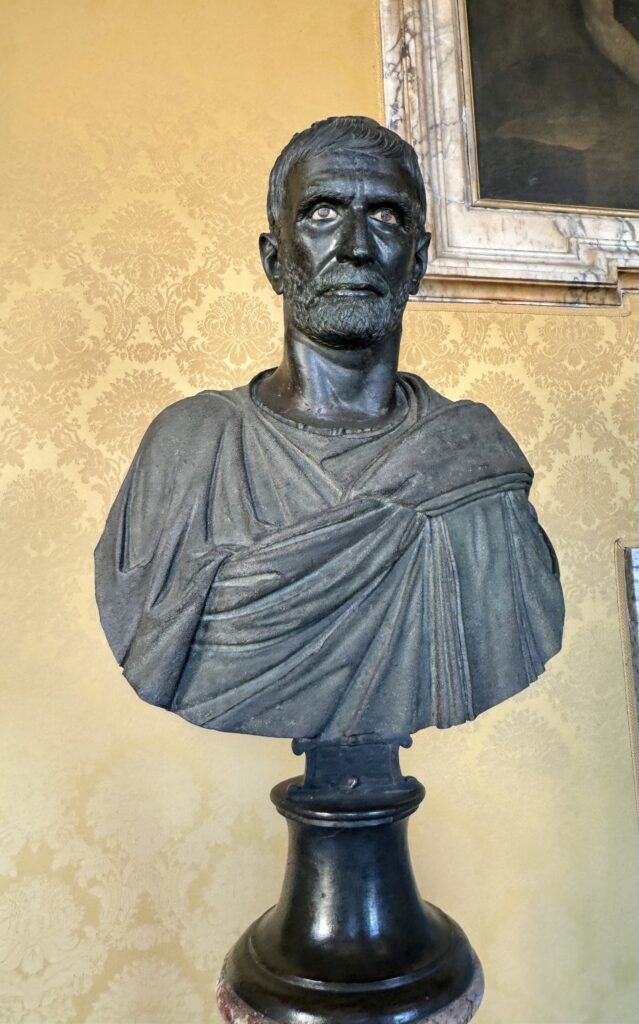
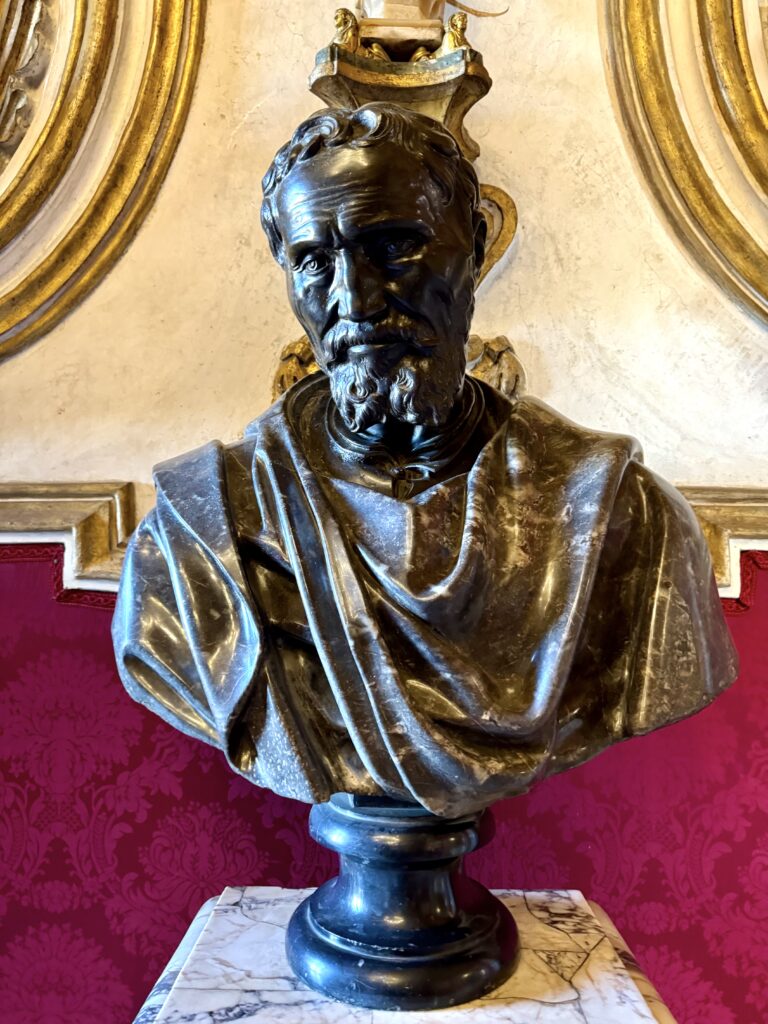
Practical Guide & Tips for Visiting the Capitoline Museums
Address: Piazza del Campidoglio 1.
The entrance and ticket office are in the building on your right after you climb the stairs. The museum is in the center of Rome, a very short walk from the Roman Forum or Piazza Venezia.
Entry fee:
16 euros. The audio guide (which is worth it) is 6 euros. Click here to book a ticket. You can also purchase a Roma Pass at the museum ticket office.
If you opt for the audio guide, you’ll need to leave your passport or license as security. You can also purchase tickets online to avoid the queue at the ticket office in high season. Free on the first Sunday of each month.
Hours: Daily 9:30 am to 7:30 pm
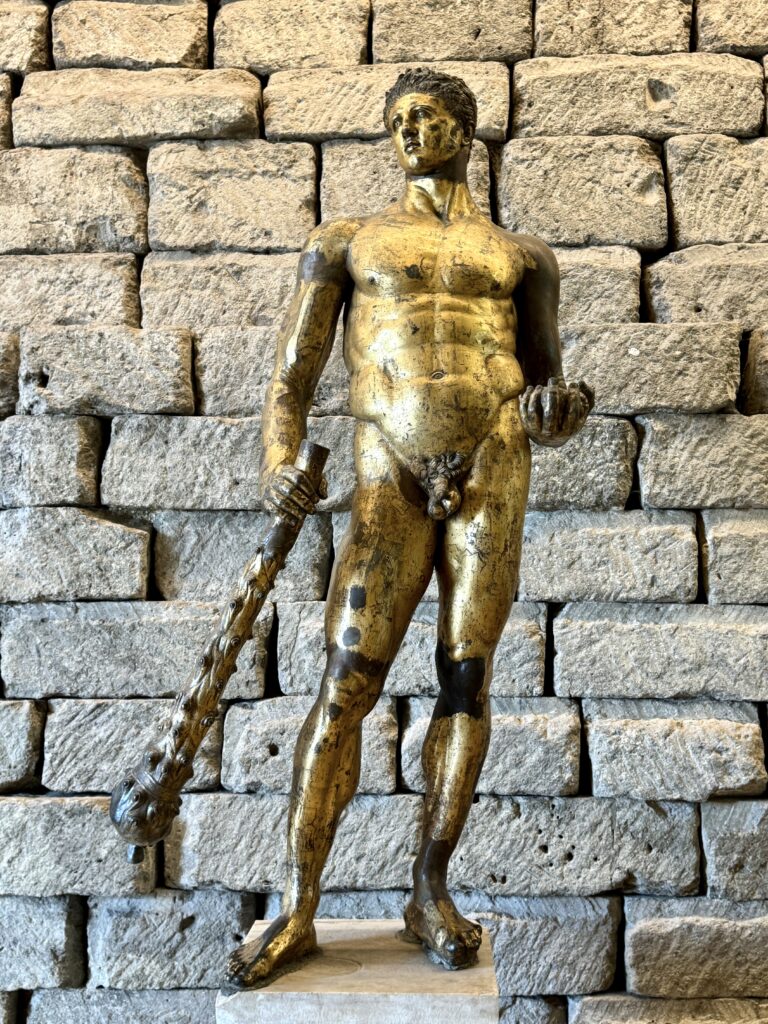
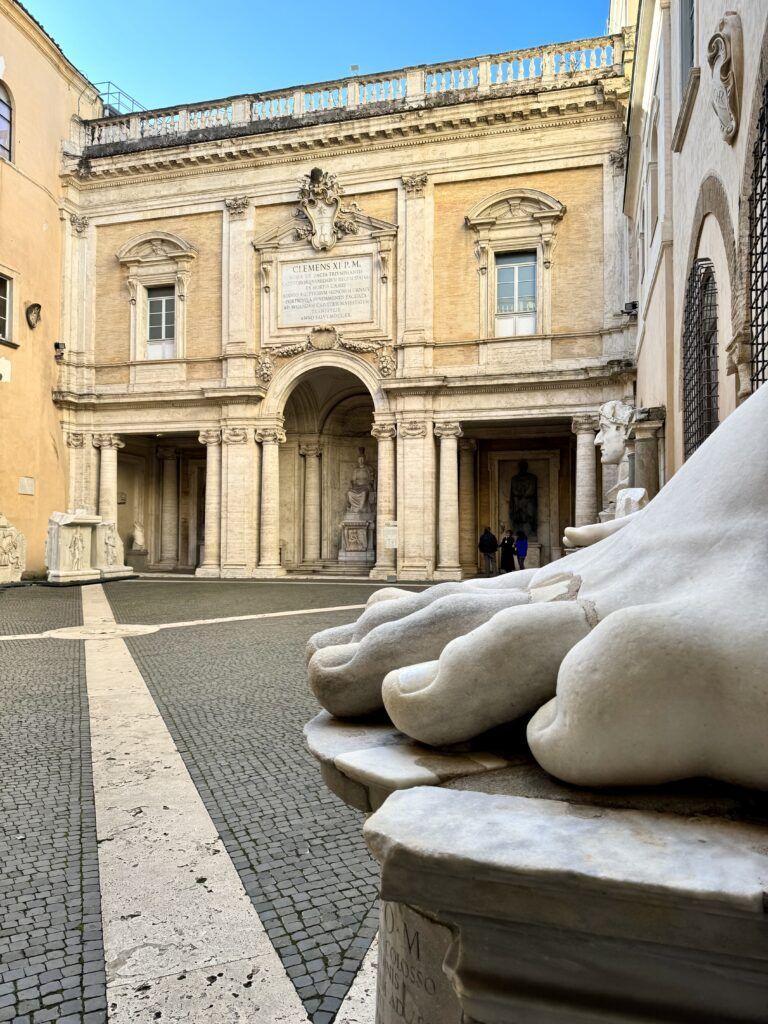
Pro Tips:
If you have anything more than a small purse, you’ll be required to check it. The cost is 1 euro, so have coins.
Pick up a map when you enter. This museum is confusing. It’s easy to get lost and miss important pieces.
I hope you’ve enjoyed my guide to the Capitoline Museums in Rome. You may enjoy these other guides to must see art in Rome:
- 8 ways to spend 1 day in Rome
- 3 day itinerary for Rome
- 5 day itinerary for Rome
- Hidden gems in Rome
- Best museums in Rome
- Archaeological sites in Rome
- Guide to the Borghese Gallery
- Guide to Palatine Hill
- Guide to the Roman Forum
- Guide to the Colosseum
Pin it for later.

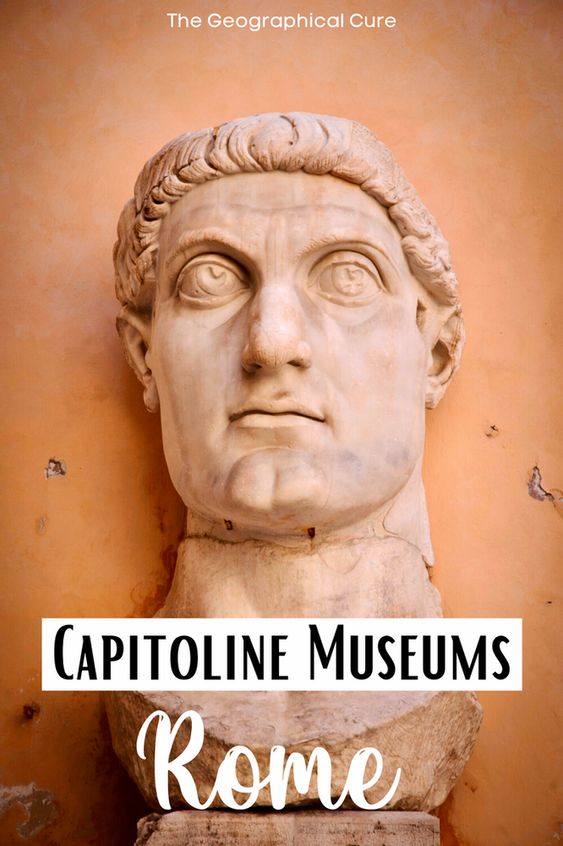
This looks great. I’m coming to Rome next week. Do you know any tour guides for the Capitoline Museums?
This is such a great museum. But it’s huge and rambling. A guide is a good idea. Here’s one to consider: https://www.getyourguide.com/rome-l33/capitoline-museum-small-group-tour-t53321/?partner_id=3J67DR2&utm_medium=online_publisher&placement=content-middle.